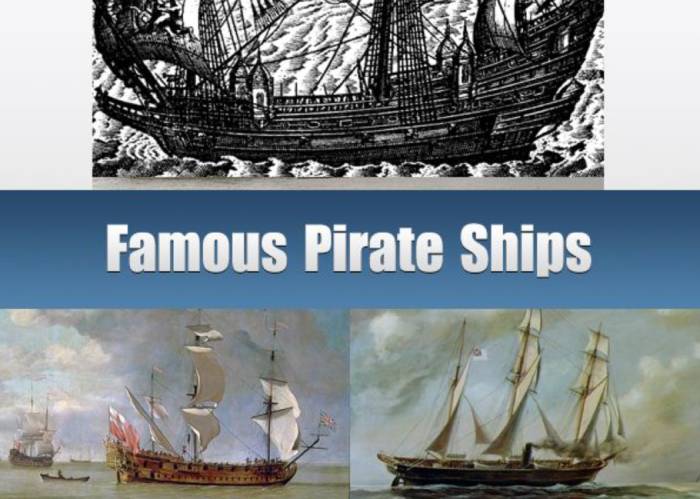Pirates, buccaneers, corsairs, and other scurvy sea dogs robbed merchantmen and treasure fleets during the so-called “Golden Age of Piracy.” Some of these men, such as Blackbeard, “Black Bart” Roberts, and Captain William Kidd, became very famous.
What about their pirate ships? As famous as the men who sailed these ships were the ships these men used for their dark deeds. The following are a few famous pirate ships.

Table of Contents
Blackbeard’s Queen Anne’s Revenge
One of history’s most feared pirates was Edward “Blackbeard” Teach. He captured La Concorde, a massive French ship used to transport enslaved people, in November 1717. After refitting the Concorde, he mounted 40 cannons on board and renamed her Queen Anne’s Revenge.
Blackbeard ruled the Caribbean and the eastern coast of North America with a 40-cannon warship. The Queen Anne’s Revenge ran aground in 1718 and was abandoned. The Queen Anne’s Revenge was found sunken off the coast of North Carolina in 1996. Some items including a bell and an anchor are on display in local museums.
Bartholomew Roberts’ Royal Fortune
Over the course of his three-year career, Bartholomew “Black Bart” Roberts captured and looted hundreds of ships. Over the course of this time, he had several flagships, and he named them all Royal Fortune.
Royal Fortune was a 40-cannon behemoth manned by 157 men that could compete against any Royal Navy ship of the time. In February 1722, Roberts was aboard the Royal Fortune when he was killed in battle with the Swallow.
Sam Bellamy’s Whydah
Sam Bellamy captured the Whydah (or Whydah Gally) in February 1717, a large British ship used to transport enslaved people. For a short time, he terrorized Atlantic shipping lanes with 28 cannons mounted on her.
In April 1717, barely two months after Bellamy first captured her, the pirate Whydah was caught in a horrendous storm off Cape Cod. In 1984, the wreck of the Whydah was discovered and thousands of artifacts were recovered, including the ship’s bell. In Provincetown, Massachusetts, a museum displays many of the artifacts.
Stede Bonnet’s Revenge
The most unlikely pirate was Major Stede Bonnet. As a wealthy plantation owner from Barbados with a wife and family, he suddenly decided to become a pirate at the age of 30. In 1717, he outfitted a ten-gun sloop he called the Revenge, becoming the only pirate in history to own his own ship.
Despite telling the authorities he was going to apply for a privateering license, he went pirate immediately after leaving the harbor. Having lost a battle, the Revenge met up with Blackbeard, who used it while Bonnet rested. Betrayed by Blackbeard, Bonnet was captured and executed on December 10, 1718.
Captain William Kidd’s Adventure Galley
William Kidd was a rising star in seafaring circles in 1696. As a privateer, he captured a large French prize in 1689, and he later married a wealthy heiress. He convinced some wealthy friends to fund a privateering expedition in 1696.
In order to hunt French vessels and pirates, he outfitted the Adventure Galley, a 34-gun monster. The crew forced him to become a pirate not long after he set sail, but he had little luck. He turned himself in in New York hoping to clear his name, but he was hanged regardless.
Henry Avery’s Fancy
Henry Avery was an officer onboard the Charles II in 1694, an English ship serving the King of Spain. As a result of months of poor treatment, the sailors on board were ready to mutiny, and Avery was ready to lead them. Avery and his fellow mutineers took over the Charles II on May 7, 1694 and renamed her the Fancy.
In July 1695, they captured the Ganj-i-Sawai, the treasure ship of the Grand Moghul of India, in the Indian Ocean. The pirates made one of the largest scores in history. When Avery returned to the Caribbean, he sold off most of the treasure: he disappeared from history, but not from popular legend.
George Lowther’s Delivery
George Lowther served as second mate on board the Gambia Castle, a midsized English man of war, in 1721. By the Gambia Castle, a garrison was being transported to a fortress on the African coast. It was found that the soldiers’ new accommodations and provisions were insufficient.
Having fallen out of favor with the captain, Lowther persuaded the soldiers to mutiny. In an attempt to engage in piracy, they took over the Gambia Castle and renamed it Delivery. After a relatively long career as a pirate, Lowther traded the Delivery for a more seaworthy vessel. After losing his ship, Lowther died marooned on a desert island.
